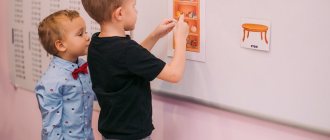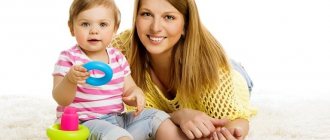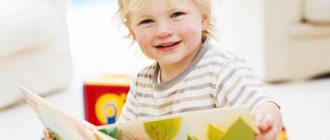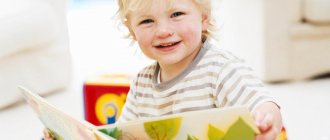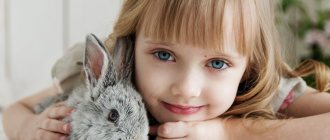According to the theory of Daniil Borisovich Elkonin (a psychologist of the Soviet period), with normal mental development, the child’s attention is mainly focused either on emotional communication or on objective activity. And for children of the fourth year of life, relationships with other people again come first, as it was at the age of birth to one year, for example. Most of all, children are now interested in role-playing games. This means that the main thing is to be able to communicate using language in order to play these games.
Features of development of children 3 years old
Three years is an important age in the life of a baby. At this time, great changes occur in his psyche. A calm, obedient child suddenly becomes capricious and uncontrollable, and the parents are perplexed: what happened?
There's no need to worry. In psychology, there is such a thing as the three-year crisis. It is he who provokes such changes in the behavior of children. The first signs of an emerging crisis become noticeable as early as two years of age. By the end of the third year of life, the crisis reaches its peak.
The crisis of three years can be recognized by the following signs:
- Negativism. The child refuses all requests and suggestions from the parents. This greatly irritates adults, but you need to understand that in this way the baby learns to recognize himself as a separate person.
- Stubbornness. The baby becomes very stubborn. He demands that his wishes be fulfilled immediately, and if this does not happen, he throws a tantrum.
- The desire for independence. The child tries to do everything himself - dress, wash, brush his teeth, etc. Adults’ attempts to help him are categorically rejected.
- Conflict. The child becomes conflicted: he contradicts his parents, swears, ignores their requests, and protests against the established rules.
- Jealousy. The baby begins to be jealous of his parents for his brothers or sisters. If there are none, he may begin to be jealous of mom and dad.
These changes in behavior are age-related features that go away over time.
What mistakes can parents make when developing their child’s speech?
Often the child is overly patronized and protected, they try to predict his desires - of course, out of love for him.
But then the baby does not develop the desire to work independently, he does not learn to express his thoughts through speech, and many processes in his development may be inhibited. • Intuition and love help loved ones understand a child literally at a glance. But communicating with unfamiliar people in unusual conditions will be difficult for him, and in the worst case, acutely uncomfortable. To prevent this from happening, as you grow older, you need to enter into conversations more often with new and new interlocutors, and then the child will simply be forced to improve his speech understanding skills.
• Some parents underestimate, while others overestimate, the requirements for the baby’s speech. In the first case, they do not demand anything from the child, all his wishes are guessed and immediately fulfilled, in the second, they constantly pester him: “Tell me!”, “Repeat!”. Sometimes in one family two extreme approaches are used at once: for example, dad demands, and grandmother takes care. This has a very adverse effect on the child’s speech development.
• Try to eliminate lisping, “baby talk,” and constant onomatopoeia when communicating with your baby. The parent's speech is a model for the child.
• Parents can speak very quickly or, conversely, too slowly, without pauses and different intonations, monotonously. It is important to use all the richness and diversity of language when developing a child’s speech.
• Do not try to speed up the baby's natural speech development. Avoid overwork from speech classes and memorization of poetry.
Intellectual development
At this age, visual-effective thinking is transformed into visual-figurative thinking. If previously the baby learned about the world through direct contact with various objects, now he can already operate with images of these objects stored in his memory.
At three years old, a child should be able to:
- understand simple cause-and-effect relationships;
- demonstrate first action planning skills;
- compare objects by size, shape, color;
- put together simple puzzles from four large parts;
- know the basic colors and be able to name them;
- know the names of surrounding objects (dishes, furniture, products), animals;
- know the names of basic geometric shapes.
An important feature of this age is that a growing baby can think and reason about objects that are not in the field of view. This is an important step towards further development of thinking.
Speech development
The speech of a three-year-old is very different from the speech of a two-year-old baby. At this age, the child already has a fairly large vocabulary - from 1000 words. The baby can reason and make simple conclusions about people, objects and phenomena.
Children actively remember new words, play with them (change pronunciation, rhyme, come up with sound combinations). Long, complex words are still difficult for babies to pronounce, so they mutilate them.
A 3 year old child should be able to:
- tell how his day went;
- use sentences of 3–5 words or more in speech;
- describe the picture;
- memorize poems and songs;
- name not only the object itself, but also its details (handle of a cup, nose of a dog);
- establish semantic connections between objects;
- ask and answer questions;
- Use polite words (“thank you”, “please”).
Three-year-olds do not yet have very well developed speech. They pronounce hissing and sonorant sounds poorly. They construct sentences incorrectly and lose the endings of words. All this is the norm of development. With age, problems will be eliminated.
Child’s speech at 3 years old: deviations
A child has deviations from the norm if he:
- Experiences serious difficulties when retelling, that is, he cannot remember the content of a short simple text that is age appropriate, such as “Kolobok”, “Ryaba Hen”, he understands it poorly, cannot formulate a thought;
- Incorrectly pronounces more than 5-7 sounds by the age of 4 (three-year-old children are still allowed to do this);
- Uses onomatopoeia and simplified versions of words instead of full ones;
- Has a small vocabulary;
- Has difficulty pronouncing words - repeats sounds or syllables (instead of a machine - mmmashina, instead of a cartoon - mumumultik);
- Talks too fast.
The last 2 points are sometimes associated with stuttering.
Have you noticed these problems in your child? It is worth considering seeing a speech therapist. Because in this case, parents often do not have the necessary knowledge and will not be able to help the child on their own.
Neuropsychic development
During this period, the performance of the nervous system increases. The baby can already restrain his emotions, for example, not cry when he is hurt or offended.
His ability to concentrate increases. Now he can do something for 10–15 minutes without being distracted by anything else. Distracting a crying three-year-old by redirecting his attention is not so easy, because he has already concentrated on his negative emotions.
At this age, the child cannot yet properly manage his behavior. The three-year crisis mentioned above also adds to the difficulties. The baby's inner world is full of contradictions that result in whims and hysterics.
I. A. Galkina (Ph.D.)
The age from three to five years is called middle preschool. According to L.S. Vygotsky, during this period children develop completely new relationships between thinking and action, an internal plan of action appears that determines meaningful behavior. Let us consider the age-related features of the development of a child from three to five years old. Their knowledge will help parents not to miss important milestones in the development of their children’s personalities, to notice possible difficulties in time and to correct them.
PHYSICAL DEVELOPMENT
- Reaction speed, coordination and speed of movements are noticeably improved, agility and flexibility appear. Now children become good partners in outdoor games. Their gross and fine motor skills improve.
- The proportions of their body change. Now they are approaching the proportions of an adult’s body, the center of gravity is shifting downward.
- Weight increases due to the growth of bone and muscle tissue. Moreover, boys have more muscle tissue, and girls have more fat. An increase in fat mass occurs due to an increase in volume, not the number of fat cells. At this age, the proportionality of the increase in height and weight is important. If you suddenly notice that the weight data has a clear tendency to overtake the height measurement data, it means that the child is becoming overweight. At an early age, it is important to instill in your child a culture of nutrition so as not to increase fat potential.
- The cartilage gradually becomes hard. The correct formation of the skeletal system largely depends on the quality of nutrition. The child’s diet must contain dairy products, fish, meat, and a sufficient amount of vitamins and minerals.
- All internal organs increase in size, their functions improve, approaching adult norms and proportions.
- The nervous system is also improved. The number of nerve cells increases, the number of connections between them becomes more complex and expands.
- By the age of four, a child should already have a full set of baby teeth. If there are less than twenty of them, then you should seek advice from your local pediatrician or dentist.
MOTOR SKILLS
Three years . The child’s motor skills are enriched: he runs confidently, speeds up and slows down, changes direction, can catch a ball and maintain balance, climbs and descends stairs well, and rides a tricycle. At this age, the baby is able to dress and undress independently, knows how to fasten and unbutton buttons, and put on Velcro shoes. At three years old, a child is already well oriented in space and can easily find the object he needs or complete some task of finding a toy. He also has good hand-eye coordination. He already knows how to use scissors, eat on his own, and drink from a cup.
Four years . Motor activity improves: the child can stand and jump on one leg, walk backwards, jump to the side, forward and backward, alternate running with jumping, jump over low obstacles, march to the beat of the music. Also during this period, a preference for the right / left hand is clearly formed.
Five years . Control over body movements is noticeably improved. All the skills that the child acquired before this age are improved. The space for activities is expanding. At this age, the baby is good at catching a ball with both hands, riding a two-wheeled bicycle, rollerblading, jumping rope, deftly overcoming obstacles, walking on a log, and doing simple dance movements.
MENTAL DEVELOPMENT
The age from three to five years is the most important stage in the development of a child. This period of development is characterized by rapid assimilation of information, so parents should take care of organizing exciting activities with their baby.
At the age of three, a child interacts with the world based only on acquired knowledge. He remembers what happened to him in the past and, based on past experience, makes decisions, confirming old ones or acquiring new skills. The child’s memory in this period of development is involuntary: memorizing information and imprinting images occur by themselves. Children easily remember poems, fairy tales, dialogues from films, and empathize with characters from books and films. By the age of five, memory and attention develop significantly: the child remembers up to 5 words at the request of an adult; carries out instructions consisting of 2-3 consecutive actions. Attention becomes voluntary - a child of four or five years old, if he is asked to constantly say out loud what he has in his field of attention, he will be able to hold it for a long time. The stability of attention increases when looking at attractive objects, listening to fairy tales, and performing intellectually significant actions (puzzle games, riddles).
By the age of four to five, mathematical concepts and numeracy skills are developed. Children use the words “many” and “one” in their speech; name geometric shapes and shapes, learn to identify geometric shapes in surrounding objects. They know and name the seasons and parts of the day. There are right and left hands.
The child’s imagination improves; by the age of four or five, the imagination is so developed that with its help the child can create a simple program of actions in his mind. He gradually learns to replace real objects and situations in his imagination with imaginary ones, this ability especially develops by the age of six or seven.
From four to five years old, children begin to think in images. The child easily remembers, reproduces the information received and actively expands his knowledge about the world around him. This leap in a child’s development occurs due to the development of speech and creative thinking.
SPEECH DEVELOPMENT
At the age of three to five years, active development of speech continues: the vocabulary expands significantly, the child begins to use a variety of nouns and verbs, names the location of objects, and characterizes the emotional states of people. The use of prepositions is expanding, imperative forms of verbs are being used, and sentences are becoming complex. The child is able to retell a short fairy tale, compose a story based on a picture, dialogue speech improves: he maintains a conversation, asks questions and answers them correctly. In general, speech becomes more expressive, contextual, i.e. the child is able to describe a situation in such a way that it is understandable without directly perceiving this situation. The period of four to five years is the peak of the sensitive period of speech development, and provided that the pronunciation of the native language is formed and there are no speech therapy problems, the child can be recommended to begin learning a foreign language.
Normally, a four to five year old child should speak clearly and pronounce all sounds correctly. If a child has difficulties with pronunciation, then you should seek help from a speech therapist. Speech disorders can also be a consequence of hearing impairment. There is a law: as a child hears, so speaks. If your child leaves out some sounds, such as hissing sounds, he may not hear them.
In order to develop your child’s speech more intensively, you need to talk to him more often. And it is important that contact be mutual as often as possible, that is, in the form of dialogue. Parents should not limit themselves to the simplest topics; they can already discuss cartoons and books they have read, relationships with peers and adults.
PERSONAL DEVELOPMENT
The age from three to five years is the most important stage in the development of a child as an individual. At this age, long-term memory is formed. The baby already perceives himself as a separate, unique person, and feelings and emotions form childhood memories and his own unique experience. At this age, the child begins to develop and actively develop character traits such as self-esteem, self-worth, and a sense of dignity.
Imitation remains the main mechanism of personality development. The child is guided by the assessments of adults. Knowledge about oneself becomes more stable, self-esteem begins to form. A child of four to five years old evaluates himself more realistically than at the age of three; he reacts to the praise of adults, correlating his successes with it. An important factor in the development of a child’s personality is the group of peers; the child compares himself with other children, they act as a mirror for him - a peer personifies realistically possible achievements in various types of practical activities, helps to determine his own qualities.
At this age, the child does not yet appreciate the complexity of the task facing him; it is important to him that he coped with it and was praised, but what matters is not so much one-time success as the sustainability of success. By correlating his results with the results of other children, the child learns to correctly assess his capabilities. He develops a level of aspirations and develops an internal position.
After three years, the child begins to see himself from the outside and realize his gender identity. This also needs to be taken into account by parents in order to instill the necessary female and male behavior patterns in a timely manner.
GAMES AND TOYS
Play for a child is a leading activity. From the outside it may seem that the child is having fun while playing, but in fact he is doing important work. In the game, children realize their desire for independence, learn patience, perseverance, communicate with peers, control their behavior, and also develop will, imagination, thinking and moral attitudes.
In games, children already adhere to certain rules and strictly control them, think through the plot of the game in advance and divide roles among themselves. Role-playing play at this age is very important, but the child must be able to play not only in company, but also alone - when only his imagination is involved. A child who plays by himself is more independent of the situation; such a child can be left alone for a while, and he will not experience feelings of anxiety. You can gradually teach your child to play independently. You start a game with him, engage him, then leave the room for a few minutes. An enthusiastic child, by inertia, continues to play alone and gets used to the fact that the constant presence of an adult is not necessary.
In order to develop various aspects of a child’s intelligence, it is necessary that the toys be different: toys for intelligence (simple puzzles), toys that develop spatial thinking (constructors, sets of cubes), toys that develop creative thinking (mosaics, kaleidoscope), etc. Notice with what pleasure your baby plays in the sandbox, what intricate figures he creates from raw sand. At home, such a sandbox can be successfully replaced by plasticine and clay. More often engage in modeling, drawing, appliqué, etc. with your child. These activities develop the child's creative thinking and creative abilities.
Middle preschool age is an important stage of child development. He masters a lot of new knowledge, skills and abilities that are extremely important for his further full development. The task of parents is to expand the child’s horizons as much as possible. This age can be called the age of “intellectual hunger” - the baby wants to know about everything and asks a lot of questions, sometimes very unexpected and difficult. It is very important to answer them and form the right values in the child. By doing this in a playful way during this period, you can lay the foundations for moral development, which will certainly bear fruit in later years.
In order for the development of a child aged 3 to 5 years to be successful, it is important not only for the parents to properly raise children, but it is also advisable for children to attend special classes conducted by experienced psychologists. Our children's development center has an additional general developmental program “Psychological developmental activities”, which is designed for children of this age. We will talk about this program in the second part of our article.
Math skills
At 3 years old, children already have some mathematical skills. They must know and be able to:
- count to five forward and backward;
- show the number on your fingers;
- know what numbers from 1 to 5 look like;
- compare the number of objects in different groups using the concepts “more”, “less”, “same”;
- know and be able to draw basic geometric shapes (circle, square, triangle, oval, rectangle);
- recognize the outlines of geometric shapes in various objects (a clock is a circle, a TV is a rectangle).
Some kids already know all the numbers from 0 to 10 and can write them. This is a good help for future preparation for school.
Physical development
A 3-year-old child controls his body much more confidently than a 2-year-old. At this age, children can:
- jump on two legs in height and length;
- stand on one leg without falling;
- jump over obstacles;
- run quickly and confidently;
- climb the wall bars;
- ride a tricycle or scooter;
- ride downhill;
- kick the ball.
Kids love physical activity and quickly develop their abilities.
Causes
Psychologists cannot accurately and unambiguously name the specific causes of age-related crises. Certain influencing causes of the 3-year crisis and factors that can be traced in certain situations are identified.
- Features of the child's temperament . Children with a weak or unstable type of nervous activity are more likely to experience a crisis with the most acute manifestations. It is especially difficult for children with choleric temperament or melancholic children. Sanguine and phlegmatic people are less susceptible to crisis changes.
- Authoritarian parenting is another reason for the serious crisis of preschool age. The constant dictatorship of parents, suppression of initiative and ignoring the wishes of the child leads to violent protests.
- Increased anxiety of parents and excessive care for the baby (overprotection) . The child’s aspirations and desires are suppressed due to excessive worry about his health. Parents do not consider the child independent; they do everything for him.
- Health problems . Mental disorders, neurological diseases and severe chronic pathology affect the reactions of children.
- Conflicts within the family . In this case, psychologists give recommendations for parents - not to involve the child in adult problems and to protect him from clarifying parental relationships and negativity.
Logical thinking
At 3 years old, children already have some logical thinking skills. They must be able to:
- combine two objects into a logical pair (“pencil-paper”, “tea-cup”);
- exclude unnecessary items from a group;
- understand the logical sequence of events (clouds gathered in the sky - it began to rain - the ground became wet);
- highlight the main properties of objects and combine them into groups according to these properties;
- understand time sequence (“yesterday”, “today”, “tomorrow”, “now”, “later”);
- distinguish opposites (big - small);
- understand the location of objects in space (“above”, “below”, “above”, “below”).
Self-care skills
Children at 3 years old can already do a lot on their own, without the help of their elders. For example:
- dress, undress, fasten and unfasten zippers and large buttons;
- putting on shoes (it’s normal if the baby puts shoes on the wrong foot);
- confidently wield a spoon and fork, drink from a cup, wipe your mouth with a napkin;
- wash your face, wash your hands, brush your teeth;
- put toys back in place;
- carry out small household tasks (lay out cutlery on the table, pour food into the cat’s bowl).
The less parents try to help the baby, the faster he develops everyday skills.
Fine motor skills
The youngest preschooler actively develops and improves fine motor skills. He must be able to:
- hold a pencil, felt-tip pen, or drawing brush correctly;
- trace simple drawings using dots;
- draw geometric shapes, straight and broken lines;
- write familiar block letters;
- use scissors to cut simple shapes from paper;
- shade the drawing in different directions;
- coat the paper appliqué parts with glue and glue;
- sculpt balls and sausages from plasticine and connect them.
There are many finger games for developing a child's fine motor skills.
What does a baby learn from 1 year to 1 year 3 months?
It is now that he acquires the most important skills in the areas of walking, speaking and thinking.
Physical skills of a baby from 1 year to 1 year 3 months:
We hope that you have studied our material on walking and taken care of creating a safe space for your baby to teach this skill.
- The process of learning to walk requires enormous effort from the baby; he explores the terrain, does not avoid difficult places, and often falls. But don’t worry: this is how a child learns coordination of movements and a sense of balance. Sometimes the baby starts crawling again.
- Do not deprive your child of movement under any circumstances: this can cause a nervous breakdown, irritation, or apathy and lethargy.
- During this period, the baby surprises us with amazing curiosity and a passionate desire to learn as much as possible about the world - right now we need to make sure that he does not touch dangerous things. There is no need to try to remove all the objects that the child wants to pick up - let your young explorer accumulate sensory experience, he needs it.
Of course, he cannot do without painful sensations at all - but this does not cause fear in the baby, but, on the contrary, gives an impetus to act even harder.
Psycho-emotional development of a baby from 1 year to 1 year 3 months:
During this period, the child’s nervous system continues to develop, but the will is not developed, he is impulsive, and does not yet know how to regulate the manifestations of his feelings: everything causes keen interest and a change of emotions. He is attached to his parents, misses them, recognizes them in photographs, and loves to play with them. He is afraid of strangers.
Does your baby crush, tear and break everything he touches? In fact, his behavior is a reason to rejoice: this is exactly what a child needs for development.
This is what he learns this way:
- Imitate adults - the baby wants to take exactly the object that is in the hands of the parents;
- Gain skills in handling new objects and toys, from blocks to inserts. Now the baby will like toys that consist of parts that are easy to separate and connect. We talk in detail about what toys a child needs during this period, here (link to the Toys media center);
- Analyze, compare and generalize - what will happen if you pull a sheet of paper from a book towards you? What if you throw the cube on the floor? This is how sensorimotor intelligence is formed.
Also, the baby’s speech is now actively developing - we advise you to get acquainted with the material on this topic. So far he understands much more than he can say.
He knows how to hold a cup and a spoon in his hands, he can drink and eat with a spoon on his own, but the help of an adult is still necessary.
The world
At three years old, children already have certain knowledge about the world around them. They distinguish between wild and domestic animals, know the names of some trees, flowers and other plants. Kids also know the names of vegetables and fruits and imagine where they grow (in the garden, in the forest).
Three-year-olds should already know the seasons and days and their sequence, the names of the days of the week and months. Also, kids must remember their first and last name, the names of family members, and the name of the city.
Children must be taught basic safety rules (not to go outside without their elders, not to run out onto the road, not to touch medications, sharp, hot objects, not to turn on appliances).
Key symptoms of the crisis: 7 major changes
To one degree or another, the manifestations have similar features in all children; only the severity of the key characteristics of the 3-year-old crisis differs. Parents describe common manifestations as changes in behavior and disobedience, scandals and hysterics, tears literally over every little thing. Psychologists identify 7 main symptoms of crisis behavior:
- Negativism . The child flatly refuses to follow the instructions of adults, even if this request is beneficial to the child himself. To any requests - a clear “no”.
- Obstinacy . The baby suddenly changes his habits and does not want to adhere to the regime. Through scandals and hysterics, he tries to win the right to do as he wants.
- Stubbornness . The child makes a decision and strictly adheres to this line. It is impossible to force, persuade or motivate him to do certain habitual actions. He will cry, but clearly stand his ground.
- Self-will . The baby wants to do things on his own, ignoring the parents' prompts or words.
- Protest . The peculiarities of this characteristic are a storm of emotions in relation to his parents’ instructions about what he should do. If parents have chosen or decided something for him, the child refuses these things or actions.
- Depreciation . The baby stops appreciating those things or actions that were previously important, loved or dear to him. He may throw and break his favorite toys, call his parents names, fight with his brothers and sisters, and refuse his favorite treats.
- Despotism . The child tries to command family members, demands submission and unquestioning obedience. If his whims are not fulfilled, hysterics and screams follow, stamping his feet and raising his voice. Source: D.M. Shakirova, A.F. Gilmanova. Age crises in children of preschool and school age // Skif. Student Science Questions, 2022.
Not all of these signs may manifest themselves equally clearly; sometimes certain symptoms predominate, which are triggered most often and which the child uses as an instrument of influence.
Development of attention
Three-year-olds must have the following skills:
- concentrate on the task at hand for 10–15 minutes;
- keep up to five objects in your field of vision at the same time;
- remember and repeat after an adult the suggested words and movements.
It is worth remembering that the attention of a junior schoolchild is still unstable and easily scattered.
Reasons for silence
In the modern world, most children begin to speak much later. But not all parents know about this, so they immediately begin to look for reasons in the baby.
The causes of speech delay can be social and biological.
Social causes can be eliminated on your own; if biological causes are detected, you should consult a doctor.
Social
Tense family relationships. The speech apparatus is not developed in children whose parents have little communication both with each other and with their “silent one.” To eliminate the problem, you need to reconsider the relationship in the family, especially between mom and dad. As a rule, when various descriptions, actions, and emotions are added to speech, the baby begins to repeat after adults and speak.
Frequent colds in children. If the baby is sick a lot and is isolated from other children, disturbances in his speech will be noticeable. Parents of such a child should allow him to explore the environment and people around him so that speech is restored as soon as possible.
Rough treatment of a child. If constant physical or psychological abuse occurs at home, then not only speech, but also the entire health of the baby as a whole will suffer.
Pedagogical neglect . Many parents mistakenly believe that their child is smart and capable from birth and that developing skills does not require effort. But that's not true. Other mothers and fathers shift responsibility to teachers in kindergarten and teachers at school. They forget that it is the family that lays down the child’s abilities.
Lots of language learning. Often, due to the desire to learn several foreign languages, a parent forgets to pay due attention to Russian literacy and speech.
Emotional stress. The reason for the lack of speech data in a baby may be an event that caused negative emotions, fears, or emotional disorders . In this case, you should seek help from a psychologist or speech therapist.
Excessive control. Parents often forget that they need to develop independence in their children. Moms, trying to protect their child from negativity, only make things worse for him. Indeed, due to overprotection, there may be a slowdown in overall development, and, in particular, speech.
Loaded information environment. If there is too much information around the baby, for example, a computer, TV, radio, telephone, he very quickly becomes isolated and withdraws from the world around him.
Biological
Heredity . As a rule, children pronounce their first words at the same age as their parents. If mom or dad started talking late, then the baby will also be slightly behind in development. There is no need to worry about this, because this is not a pathology, but just a hereditary factor.
Hearing loss. In the modern world, a large number of children are born with hearing loss or hearing loss. Such kids need more attentive attention to improve the development of speech abilities.
Consequences of diseases. Speech problems may be due to a previous illness or congenital injury.
Viral disease of the mother during pregnancy or lactation. Medicinal, chemical or narcotic substances in the mother's blood can negatively affect the development of the child.
Memory development
As for memory, at this age it is still involuntary. A three year old child should be able to:
- remember the plot of a short fairy tale or cartoon;
- learn short poems;
- remember the events of the day;
- remember what is shown in the picture.
The older a child gets, the better his memory works. By the end of the third year, the baby can remember much more.
What can a one-year-old baby do?
Let's see what the baby can do for his first birthday.
In the second year of life, the baby is not yet so confident on his feet, but he can stand up and sit down without the help of his parents, walk independently or with support on one side. He can chew solid foods and play more complex games with toys.
The baby can also:
- Say few words other than “mom” and “dad”, or actively babble;
- Expresses displeasure at the word “impossible”, at the harsh tone of an adult’s voice, at the inability to perform the desired action;
- Indicate body parts;
- Behave differently with different people (mom, dad, grandma, strangers);
- Find the necessary objects in the room, fulfill the requests of adults.
The child has clearly defined interests, favorite and least favorite activities, food preferences; tries to participate in dressing (raises an arm or leg), washing.
Psychologists believe that at 1 year of age a child experiences a crisis, which we talk about here.
At this age, babies are busy exploring the world and at the same time are emotional, their mood often changes, and increased attention and patience are required from parents. Now you need to help your child move from infancy to early childhood, organize all the conditions for his harmonious physical and mental development.
As a rule, the period from one year to 2 years is divided into 4 segments: 1 year - 1 year 3 months, 1 year 3 months - 1 year 6 months, 1 year 6 months - 1 year 9 months, 1 year 9 months - 2 years. Let's see how the child's development continues at this time.
Emotional development
A three-year-old already knows how to manage his emotions and restrain aggression or tears when necessary. His need to communicate with peers increases.
The baby learns to understand not only his own, but also other people’s emotions, and actively imitates adults. He strives for independence and begins to build his relationships with the world around him.
A feature of the psychology of a 3-year-old child is predominantly negative forms of behavior. This is directly related to the crisis of adolescence. Find out how to properly develop your child's emotional intelligence.
What does a baby learn from 1 year 3 months to 1 year 6 months
The baby is actively developing walking and speaking skills.
Physical skills of a baby from 1 year 3 months to 1 year 6 months:
- At 1 year 6 months, a child, as a rule, can walk independently without support - albeit not very smoothly, he will have to improve this skill in the second and third years of life.
- Many children can overcome obstacles, go up and down a children's slide, carry objects with them, and play with a ball.
- The child can take the cup and spoon himself and use them more coordinated.
- He notices if clothes are wet or dirty and reports his displeasure. Begins to master hygiene skills (makes it clear that he wants to go to the toilet). When washing his face, he tries to show that he can do it himself.
We tell you in detail how to help your child learn to speak here.
Now you need to talk to the child emotionally, but slowly, so that he understands everything, pause, build short phrases. Show your baby objects, if you talk about them, encourage his interest.
Psycho-emotional development of a baby from 1 year 3 months to 1 year 6 months:
The child has passed the one-year crisis and has become calmer, but expresses a desire to be close to loved ones, demands compliance with the regime, and strives for consistency in everyday life. He is interested in communicating with children, but does not want to share toys with them. Right now it is important to properly build relationships in a family where there are older or younger children: the child is prone to jealousy.
- The baby plays in a new way, trying to learn all the functions and capabilities of toys, reflecting the actions of adults. That is why he needs to be shown how to handle toys and objects, and spend a lot of time playing together with him.
- At the same time, the child is interested in playing with the same object for a long time, if it looks different during the game, and climbing into drawers, bags and boxes in search of interesting things. This is natural at his age and is useful for the development of mental abilities: at 1 year 6 months, the part of the cerebral cortex associated with intelligence is formed.
- During this period, the baby continues to show disobedience, with which he surprised his parents at one year old. He checks what will happen if the ban is violated. The task of parents is to predict such situations in advance and try to avoid them if we are talking about a dangerous obstacle. If your baby is interested in, for example, a puddle, you can direct his curiosity in a constructive direction - so that he plays, but does not get his feet wet.
- If the child still does something that is not allowed, you need to demonstrate your dissatisfaction: this is how the child learns; but punishments and lectures should be avoided, and the number of prohibitions should not be more than a third - the rest of your actions should be permissive. And one more thing: all family members need to follow the same rules so that he learns them faster.
- The baby continues to learn speech: by the time he is one year old, he knows on average about 10 words, but now this or that word can mean not only one object, but also similar ones with the same characteristics. This suggests that he is learning to compare and generalize. Now it is very important for him to see the world around him and find new opportunities for learning.
- By 1 year 6 months, the child knows about 30 - 40 words, and understands 10 times more. He listens carefully to his parents and looks at their facial expressions.
Musical development
It is important to develop not only reading, writing and counting skills, but also music perception, hearing, and voice. The following activities contribute to this:
- singing;
- playing musical instruments;
- dancing;
- guessing familiar songs.
Musical classes in kindergarten are an important part of children's development. At home, it is also useful to sing with your baby, dance and do gymnastics to music.
Adaptation in kindergarten
Most often in our country, it is at the age of 3 that a child receives a ticket to kindergarten. Regardless of the character and temperament of the child, adaptation occurs for everyone.
Here are some tips to help you and your child get through this period as smoothly as possible:
- Take some time to get used to it. The best option is 3-4 weeks part-time. Even if the teachers advise you to leave the child and go away, do not agree. Find an opportunity to be with him, do not leave him alone during such a difficult period. If your baby plays with children and doesn’t need you, then just watch him from the side.
- Try to create a comfortable environment in the garden and at home. Allow you to take your baby's favorite toy into the group if he asks for it.
- It is important that at home the child is given the opportunity to switch. During adaptation to kindergarten, you cannot demand that he be an angel at home. The baby gets very tired psychologically. Let him just lie at home if he wants. Or, on the contrary, he makes noise, screams and runs. He needs to learn to compensate and balance the mental load.
- Do not burden your baby with additional sections and circles. First, let him get used to one thing.
- The child needs your support. Outside the garden, give it all of yourself: chat, play, read, walk. Put down your phone and computer and spend time together.
- Talk to your child. Ask questions, find out the names of your child’s teachers and friends. Take an interest in your child's kindergarten life.
- If just a few months ago a baby was born in the family, do not send your older child to kindergarten. Having a younger brother or sister is already stressful, don't add additional stress.
- Make friends with teachers. Ask them about how your baby behaves in kindergarten and how his peers treat him.
Photo source: shutterstock.com
Sensory development
Attention should also be paid to the development of the senses - touch, smell, taste, vision. During the classes you can do the following:
- determine the texture of objects (smooth, rough);
- guess geometric shapes by touch;
- guess animal voices;
- identify odors;
- identify foods by taste without seeing them.
Children enjoy such activities and contribute to the development of their senses. Read more information about children's sensory development in our article.
Social development
A developmental feature at this age is interest in peers. A fairly rich vocabulary allows the child to communicate with other kids and master the first skills of friendship. Children begin to play group games and actively imitate adults.
It is important for three-year-olds to feel the approval of other people. They try to interact more with adults and strive to help around the house. Kids who go to kindergarten are more socially adapted than those who sit at home. Communication skills depend on the child's temperament and upbringing.
Mental development: what happens at this age? Standard options
First, let's describe the skills that a three-year-old usually possesses:
- Speech skills. By the age of 3, the child should be able to speak. But if this hasn’t happened to your baby yet, don’t panic. Just pay attention to this and consult your pediatrician.
- A child of 3 years old understands speech addressed to him. Three-year-olds, having 500-1500 words in their active vocabulary, construct sentences and even short stories, and use metaphors and images in conversation.
- He knows everything about himself: what is his name, how old is he, where does he live, the names of his parents.
- Based on pictures or descriptions, he can guess an object, find similarities and differences.
- Knows how to build cause-and-effect relationships and relies on them in his behavior. Some kids not only understand this, but also know how to explain it in words.
- The ability to make acquaintances and friendships is strictly individual. It all depends on the character of the baby. Often girls at this age already play games together, while boys show interest in playing games together later.
- There is a desire to help parents in their adult affairs. The main thing here is not to hinder your zeal and do household chores together. Believe me, with the right approach you will only enjoy the joint activities.
- By this age, the baby plays role-playing games. Now, using the example of a teddy bear or doll, you can easily explain to him why it is so important to go to bed on time and brush your teeth well. He easily integrates into your game, thereby becoming an excellent partner in joint games.
Differences in the development of boys and girls
By about three years of age, children are already aware of the difference between boys and girls and their belonging to a particular gender.
Three-year-old girls often play in groups of several people. Boys still prefer to play alone. Boys are more physically active - they run, jump and climb the sports ladder. Girls spend more time on quiet games.
